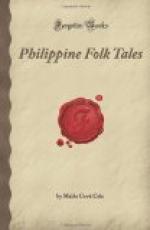[103] Usually one or more new coffins can be found in an Igorot village. They are made from a log split in two lengthwise, each half being hollowed out. Since their manufacture requires some days, it is necessary to prepare them ahead of time. After the body is put in, the cover is tied on with rattan and the chinks sealed with mud and lime.
[104] A somewhat similar idea is found among the Kulaman of southern Mindanao. Here when an important man dies he is placed in a coffin, which resembles a small boat, the coffin being then fastened on high poles near the sea. See Cole, Wild Tribes of Davao District, Mindanao, Pub. Field Museum of Nat Hist, Vol. XII, No. 2, 1913.
[105] This story, first recorded by Dr. A.E. Jenks, gives the origin of the custom of head-hunting, which plays such an important part in the life of the Igorot. The Igorot claim to have taken heads ever since Lumawig lived on earth and taught them to go to war, and they declare that it makes them brave and manly. The return of a successful war party is the signal for a great celebration.
[106] This is also the common way of making pottery.
[107] Here we have a story, recorded by Dr. A.E. Jenks, with a twofold value: it is told to the children as a warning against stinginess, and it also explains the origin of the serpent eagle.
[108] There is no jungle in the greater part of the Igorot country, the mountains being covered by cogon grass with occasional pine trees. At a distance these have a strange appearance, for only the bushy tops are left, the lower branches being cut off for fuel.
[109] First recorded by Dr. A.E. Jenks.
[110] Tattooing is a painful process, but Igorot men, women, and children willingly submit to it for the sake of beauty. The design is first drawn on the skin with an ink made of soot and water: then the skin is pricked through the pattern and the soot is rubbed into the wounds. Various designs appear on the face, arms, stomach, and other parts of the body, but the most important of all markings is that on the breast of an Igorot man. This designates him as the taker of at least one human head, and he is thus shown to be worthy of the respect of his tribe.
[111] This story also accounts for the origin of the crow and the lizard, both of which are common in the Igorot country.
[112] This story, first recorded by Dr. A.E. Jenks, while it explain the origin of the little rice bird, also points a moral, namely, that there is punishment for the disobedient child.
[113] The common way to pound rice is to place a bundle of the grain on the ground on a dried carabao hide and pound it with a pestle to loosen the heads from the straw. When they are free they are poured into a mortar and again pounded with the pestle until the grain is separated from the chaff, after which it is winnowed.
[114] According to the Klemantin myth (Borneo), the sky was raised when a giant named Usai accidentally struck it with his mallet while pounding rice. See Hose and McDougall, Pagan Tribes of Borneo, p. 142.




